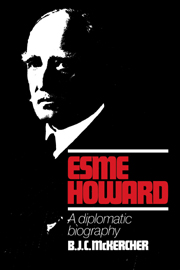Book contents
- Frontmatter
- Contents
- Acknowledgements
- List of abbreviations
- 1 The making of a diplomat, 1863–1903
- 2 Crete: consulship and civil war, 1903–1906
- 3 Washington: Imperial affairs and arbitration, 1906–1908
- 4 Budapest and Berne: prelude to the Great War, 1908–1913
- 5 Stockholm: war and diplomacy in neutral northern Europe, 1913–1916
- 6 Stockholm: diplomacy and war in neutral northern Europe, 1916–1918
- 7 Paris: Poland, the Baltic States, and the Treaty of Versailles, 1918–1919
- 8 Madrid: Anglo-Spanish relations, 1919–1924
- 9 Washington redux: rebuilding good relations, 1924–1927
- 10 Washington redux: meeting the American challenge, 1927-1930
- Epilogue and conclusion ‘A great ambassador’
- Notes
- Bibliography
- Index
2 - Crete: consulship and civil war, 1903–1906
Published online by Cambridge University Press: 06 October 2009
- Frontmatter
- Contents
- Acknowledgements
- List of abbreviations
- 1 The making of a diplomat, 1863–1903
- 2 Crete: consulship and civil war, 1903–1906
- 3 Washington: Imperial affairs and arbitration, 1906–1908
- 4 Budapest and Berne: prelude to the Great War, 1908–1913
- 5 Stockholm: war and diplomacy in neutral northern Europe, 1913–1916
- 6 Stockholm: diplomacy and war in neutral northern Europe, 1916–1918
- 7 Paris: Poland, the Baltic States, and the Treaty of Versailles, 1918–1919
- 8 Madrid: Anglo-Spanish relations, 1919–1924
- 9 Washington redux: rebuilding good relations, 1924–1927
- 10 Washington redux: meeting the American challenge, 1927-1930
- Epilogue and conclusion ‘A great ambassador’
- Notes
- Bibliography
- Index
Summary
Personally, looking at the question simply as regards Crete and Crete only, I feel sure that the sooner England can get rid of the Cretan incubus by inducing the other Powers to allow annexation to Greece the better for us, the better for P[rin]ce George, and probably, taking all considerations together, the better for Crete[,] tho that is open to doubt and is not a question that need much concern us.
Howard, October 1904Arriving in Crete on 11 July 1903, Howard faced a daunting task as consul-general. In a personal sense, he saw that success at this post would give him the career he needed to provide for his wife, and, with Isa now pregnant – the baby expected in the autumn – the pressure to succeed had increased. In a professional sense, he realised that he had been sent to the island to ensure that British influence and interests were not diminished. Crete was one of two provinces of the crumbling Ottoman Empire seeking independence from the Porte; Macedonia was the other. As such, Crete and Macedonia were the flashpoints of the on-going ‘Eastern Question’, which Powers like Britain with an interest in the Near Eastern balance of power sought to control for their own ends. Britain's chief rival in the region was Russia, whose policy focussed on the Balkans where Russian dominance might lead to the demise of Turkey-in-Europe and Russian control of the Straits.
- Type
- Chapter
- Information
- Esme HowardA Diplomatic Biography, pp. 38 - 70Publisher: Cambridge University PressPrint publication year: 1989



